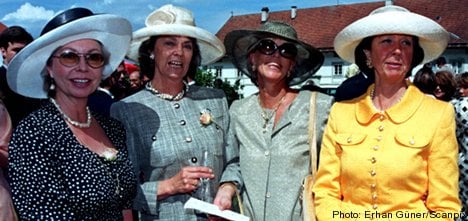The Royal Wedding is rapidly approaching. In about one month Crown Princess Victoria will finally say “I do” to Daniel Westling. Final preparations are being made for the big event, but something that has already been signed, sealed and delivered are the actual invitations for the big event.
The guest list for the June 19th nuptials and banquet have been complete for quite some time now, but the list of attendees will not be made official until the big day – just in case there are some no shows. There are a few people who are most definitely on that list though, and that is the other members of the Royal House and the extended Royal Family. The wedding will be one of the relatively rare occasions when the extended royal family will be seen in public together.
Today the Royal Family includes King Carl XVI Gustaf, his wife Queen Silvia and their three children Crown Princess Victoria, Prince Carl Philip and Princess Madeleine. They are furthermore the most well known Swedish royals.
The family does not end there however. In what is known as the Royal House you also have the King’s second eldest sister, Princess Birgitta (see photo, second from right) as well as the widow of the late Prince Bertil, Princess Lillian.
Unlike her other three sisters who married outside of royalty, Princess Birgitta married Prince Johann Georg of Hohenzollern. This entitled her to retain her royal status, her title of ‘Her Royal Highness’ and is why she is considered a member of the Royal House. Today Princess Birgitta, a mother of three, lives on Mallorca where she is known for her avid interest in golf. Princess Lillian is also a member having married directly into the family. While it is almost beyond a doubt that Princess Birgitta will attend the wedding of her niece, Princess Lillian will most likely remain at home that day. The Welsh-born Princess rarely participates in official functions these days due to her age – she will be 95 in August.
Included in the extended Royal Family are the King’s other sisters. Members of the Royal Family who married non-royals previously lost their titles. This has now changed, and Princess Madeleine will remain HRH if and when she marries. Those of the King’s sisters who married outside royalty retained their titles as princesses, but lost their right to call themselves Her Royal Highness.
His eldest sister, Princess Margaretha, Mrs Ambler (photo, second from left), has lived in England since her 1964 wedding to John Ambler. The couple had three children. The couple separated in the late 1990s, although they remained married up until John Ambler’s death in 2008. If today’s succession laws had applied in 1973, Margaretha, as the oldest child of Hereditary Prince Gustaf Adolf and Princess Sibylla, would now be Queen of Sweden. As it is, she lives a private life and carries out no official duties.
The third eldest daughter of the King’s parents is Princess Désirée, the Baroness Silfverschiöld (on the right of the photo). Like her eldest sister she too lost the right to call herself Her Royal Highness after marrying a non-royal, Baron Niclas Silfverschiöld. The couple have three children and reside at Koberg Castle in the west of Sweden.
While Margaretha and Désirée rarely participate in official functions, the King’s sister Princess Christina, Mrs. Magnuson (on the left of the photo) often takes part in state dinners as well as the Nobel festivities every December. The former chairman of the Swedish Red Cross has been married to Tord Magnuson since 1974. The couple, who live in central Stockholm, also have three children. Like two of her other sisters she too lost the right to use the HRH, but was like her sisters able to keep the honorary title of Princess.
The extend Royal Family also includes one of its eldest members, Carl Johan Bernadotte, Count of Wisborg. The former Prince of Sweden is the son of King Gustaf VI Adolf, and uncle to the present King. Born in 1916 he lost his title when he married a non-royal in 1946. He now lives with his second wife, the Countess Gunilla, in southern Sweden. The title he now holds as Count of Wisborg was bestowed upon him by the Grand Ducal Family of Luxembourg. On an interesting note, according to Wikipedia, he is also the last surviving great-grandchild of Britain’s Queen Victoria.
Marianne Bernadotte, Countess of Wisborg, the widow of Sigvard Bernadotte as well as Princess Kristine Bernadotte, the widow of Prince Carl Bernadotte, are members of the extended Royal Family as well. Sigvard Bernadotte, most known as being Sweden’s design prince, and Prince Carl both lost their princely titles because of their morganatic marriages. Carl however was made a prince by King Leopold III of Belgium, although he did not regain the style of HRH.
Not members of the Swedish Royal Family, but undoubtedly invited to the Royal Wedding are the many children of the King’s sisters. They too will get to share in their cousin, the Crown Princess’s, big day. Also included on the list are many of the Queen Silvia’s relatives from Germany and Brazil, as well Daniel Westling’s family, making the wedding a true family affair.
Juan Navas, a journalist and former information secretary at the Royal Court, is writing a series of articles about Swedish royalty in the run up to the royal wedding on June 19th. He is also blogging about the wedding for The Local



 Please whitelist us to continue reading.
Please whitelist us to continue reading.
Member comments